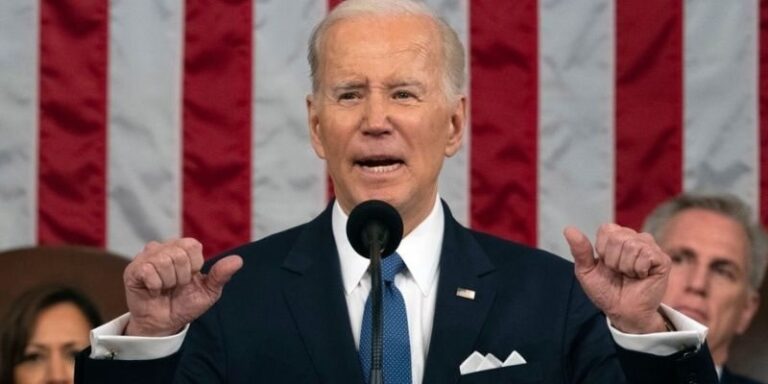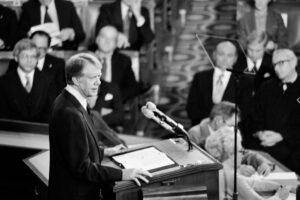Joe Biden and the State of the Union Address
The address has been delivered in person, in writing, over the radio airwaves, and, of course, via television and the internet.
By: Sarah Cowgill | February 8, 2023 | 801 Words

Joe Biden (Photo by Jacquelyn Martin-Pool/Getty Images)
Nearly every year, the president of the United States delivers a State of the Union address, often called SOTU for short, to inform America of what is going on in the government and what to expect in the near future. Typically, the address is given in January or February to the upper (US Senate) and lower (US House) chambers of Congress. The US Constitution prescribes the SOTU as a presidential duty to be performed “from time to time.” It has been delivered in person, as a written document, over the radio airwaves, on television, and over the internet.
The SOTU has become quite an event, highlighting the pomp and circumstance of the highest office in the land. Members of the House of Representatives and the Senate, along with the speaker of the House, the vice president (who is also president of the Senate), and VIP guests convene in House Chambers. The vice president and speaker sit on a dais, a raised platform directly behind where the president speaks. First, the Sergeant-at-Arms of the House announces the president’s arrival. Then, the speaker introduces the president, who delivers the speech to Congress and the nation.
It has become customary for the president to introduce invited guests and laud their individual or group achievements.
The Latest State of the Union
 President Joe Biden delivered his State of the Union address the first week of February in 2023. He attempted to give Americans peace of mind in light of rising prices, soaring inflation, and supply chain issues. He focused on solving immigration, having the wealthy pay their “fair share,” and calling out tax cheats. The president also stated that his administration created a record 12 million new jobs. He claims it’s “more jobs created in two years than any president has ever created in four years.”
President Joe Biden delivered his State of the Union address the first week of February in 2023. He attempted to give Americans peace of mind in light of rising prices, soaring inflation, and supply chain issues. He focused on solving immigration, having the wealthy pay their “fair share,” and calling out tax cheats. The president also stated that his administration created a record 12 million new jobs. He claims it’s “more jobs created in two years than any president has ever created in four years.”
Mr. Biden talked about universal healthcare and his victory at capping insulin prices at $35. He sent a strong message to the Chinese Communist Party and its leader after the Spy Balloon fiasco: “Make no mistake: As we made clear last week, if China threatens our sovereignty, we will act to protect our country. And we did.”
And he called for a ban on targeted advertising to kids on social media and for “stricter limits on the personal data that companies collect on all of us.” Mr. Biden continued to tout his infrastructure plans and glossed over America’s aid to Ukraine to fight the war against Russia. Although Mr. Biden was expected to declare another run at the presidency, he did not officially declare.
The Long and the Short of It

President Jimmy Carter (Photo by: Universal History Archive/Universal Images Group via Getty Images)
President James Earl Carter (Jimmy Carter) is the record holder for longest addresses so far: He delivered a televised and radio address of 33,667 words in 1981. The closest second place holder is President Harry Truman, who in 1946 used over 25,000 words. Finally, President William Jefferson Clinton came in a distant third place with a mere 9,190 words in 1995.
But what should also be noted is the briefest of addresses was made by one of America’s Founding Fathers: the first president of the Union, George Washington. In 1790, Washington spoke only 1,089 words, which would take about three to four minutes to deliver.
Aside from the top three listed above, it appears the most long-winded speakers were those of the 1800s: They averaged 10,000 words, while most of those in the 1900s clung to around 5,000. But that is because the content began to change drastically from the internal workings of the federal government to elected representatives to an opportunity to brag about accomplishments and encourage support for the current administration.
The first radio address was delivered by President Calvin Coolidge in 1923, and the first was televised in 1947 by President Harry Truman. Now, Americans and people worldwide can watch on television, YouTube, Facebook, and all kinds of other ways to hear from the current president.
The Designated Survivor
But there is always one person who is not invited to be in the audience of the annual message: The Designated Survivor. This person is a member of the President’s cabinet. And if something were to happen and the president, vice president, and other members in the government line of succession were hurt or incapacitated, one person would be left to carry out the president’s agenda. It is a practice in place that has never been needed to date.
The Rebuttal
After the president delivers the message, an opportunity is given for the political opposition to explain its views on the state of the nation. Usually, the person chosen to deliver this message is a rising star, an excellent speaker, and will offer alternative solutions to the current needs of Americans.
















